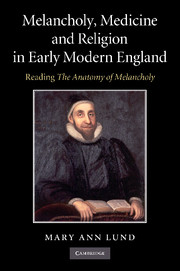Book contents
- Frontmatter
- Contents
- Acknowledgements
- Abbreviations
- A Note on Citation
- Introduction: Zisca's Drum: Reading and Cure
- Chapter 1 Imagining Readings
- Chapter 2 The Cure of Despair: Reading the End of The Anatomy of Melancholy
- Chapter 3 Printed Therapeutics: The Anatomy of Melancholy and Early Modern Medical Writing
- Chapter 4 The Whole Physician
- Chapter 5 Speaking out of Experience
- Chapter 6 The Structure of Melancholy: From Cause to Cure
- Conclusion
- Bibliography
- Index
Chapter 6 - The Structure of Melancholy: From Cause to Cure
Published online by Cambridge University Press: 23 February 2010
- Frontmatter
- Contents
- Acknowledgements
- Abbreviations
- A Note on Citation
- Introduction: Zisca's Drum: Reading and Cure
- Chapter 1 Imagining Readings
- Chapter 2 The Cure of Despair: Reading the End of The Anatomy of Melancholy
- Chapter 3 Printed Therapeutics: The Anatomy of Melancholy and Early Modern Medical Writing
- Chapter 4 The Whole Physician
- Chapter 5 Speaking out of Experience
- Chapter 6 The Structure of Melancholy: From Cause to Cure
- Conclusion
- Bibliography
- Index
Summary
In order to ‘rectifie the minde’ (III, 5) afflicted by the varied disease of melancholy, Burton designs his work in inclusive terms, so that the reader's anonymity becomes a positive element of successful cure, not its impediment. The melancholic may read advice particular to his or her physiological type and circumstances, but is also encouraged to read about all sorts of melancholic experience for his or her benefit. Burton himself plays the role of spiritual physician to his readers, while also showing himself to be a fellow-melancholic. As healer and sufferer, he displays his understanding of the disease from both the inside and the outside, an understanding which is essential as a therapeutic tool. The method of cure offered through the text is by no means an untroubled one, though, and the use of writing to relieve symptoms does not always harmoniously coincide with the aim to help others. In this final chapter I wish to turn from questions about the presentation of reader and author in order to examine how Burton's handling of the attributes of melancholy relates to what has been discussed thus far in the book. I have already emphasized at length his interest in religious melancholy and the bearing this has on the text, and further questions about theological aspects of melancholy will be explored in this chapter. The long-standing connection drawn between disease and the Fall is repeated by Burton, who portrays melancholy as an inevitable consequence of human sinfulness, and at times rebukes the reader as culpable for his or her suffering.
- Type
- Chapter
- Information
- Melancholy, Medicine and Religion in Early Modern EnglandReading 'The Anatomy of Melancholy', pp. 167 - 195Publisher: Cambridge University PressPrint publication year: 2010



